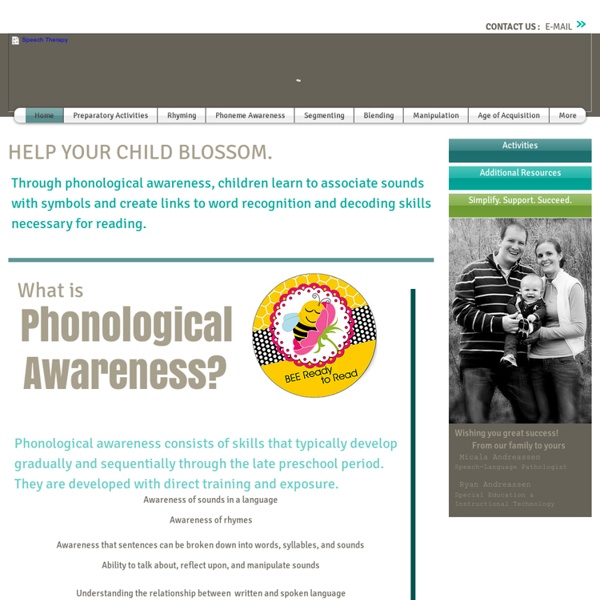



http://www.phonologicalawareness.org/
Related: PhonicsPhonological and Phonemic Awareness Phonological awareness is a broad skill that includes identifying and manipulating units of oral language – parts such as words, syllables, and onsets and rimes. Children who have phonological awareness are able to identify and make oral rhymes, can clap out the number of syllables in a word, and can recognize words with the same initial sounds like 'money' and 'mother.' Phonemic awareness refers to the specific ability to focus on and manipulate individual sounds (phonemes) in spoken words. Phonemes are the smallest units comprising spoken language. Phonemes combine to form syllables and words. Phonemic Awareness Activities Phonological Awareness Activities Packet (Aligned to Common Core) It has taken a while but we have finally completed our Phonological Awareness Activities Packet. This packet has been a huge undertaking but we wanted to accomplish a few things with it: Align the phonemic awareness activities on this page below with the Common Core Standards.Create new phonemic awareness activities for the standards we did not have existing activities for.Put all the activities in one download! What we ended up with is a 58 page Phonological Awareness Activities Download.The file was so large that we could not upload it to our Download Central Page so we placed it in Katie's TpT Store.
How Spelling Supports Reading And why it is more regular and predictable than you may think Much about spelling is puzzling. Our society expects that any educated person can spell, yet literate adults commonly characterize themselves as poor spellers and make spelling mistakes. Many children have trouble spelling, but we do not know how many, or in relation to what standard, because state accountability assessments seldom include a direct measure of spelling competence. Few state standards specify what, exactly, a student at each grade level should be able to spell, and most subsume spelling under broad topics such as written composition and language proficiency. State writing tests may not even score children on spelling accuracy, as they prefer to lump it in with other “mechanical” skills in the scoring rubrics.
Phonological Awareness: Instructional and Assessment Guidelines By: David J. Chard and Shirley V. Dickson This article defines phonological awareness and discusses historic and contemporary research findings regarding its relation to early reading. Common misconceptions about phonological awareness are addressed. Glossary of Reading Terms - The Cognitive Foundations of Learning to Read: A Framework The study of reading is a science with roots in many domains; linguists study reading, psychologists study reading, educators study reading, even computer scientists are studying reading. The process of reading has been dissected and examined from a variety of perspectives, and experts in the field have had to adopt and modify terminology or generate new terminology to describe what their examinations have revealed. Unfortunately, all of this new and precise technical terminology can be confusing - it is necessary when you are trying to describe a precise concept, but there are so many concepts in reading and reading instruction that the terminology can interfere with clear communication at times. The Reading Coherence Initiative (RCI) at the Southwest Educational Development Laboratory has put together this glossary of terms related to reading and reading instruction so that people can quickly and easily check terms as they encounter them.
Phonemic Awareness: Concepts and Research Concepts and Research Phonemic Awareness (PA) is: the ability to hear and manipulate the sounds in spoken words and the understanding that spoken words and syllables are made up of sequences of speech sounds (Yopp, 1992; see References). essential to learning to read in an alphabetic writing system, because letters represent sounds or phonemes. 20 Anchor Charts to Teach Phonics and Blends We love these models for anchor charts that focus on phonics and blends. Use them as is or adapt them for your students, and help your beginning readers take off with their confidence and learning! 1. Silent EStudents will love putting words to the test both with a silent e on the end and without. Phonetics Sounds As you know, the English alphabet is far from being a regular and consistent system of representing all the sounds in English. For instance, think of the letter group ough. How many different way can it sound like:
This site has a bunch of activities to help teachers and parents help kiddos with sounds! by sblowers Jun 6
A website full of resources on phonological awareness. by jortega Mar 12
Website with tons of activities and resources to help children learn to associate sounds with symbols by mlopezflores Mar 10